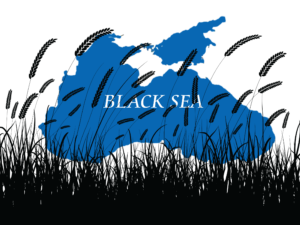In a post entitled Persistent Ocean Surveillance, I noted that Enterra’s Executive Vice President of International Security Affairs Practice, Admiral H.G. “Harry” Ulrich III, USN, (Ret.), shared in an award with the Volpe Center of the U.S. Department of Transportation’s Research and Innovative Technology Administration that recognized their work setting up a system that could track ship activity in the crowded Mediterranean Sea. That effort began in 2005 and remains a critical component of the security picture in the Mediterranean today [“Mediterranean Navies Look To Win Information War“, by Tom Kington, Defense News, 11 January 2010]. In the post mentioned above, I noted that the initiative includes participation by over 50 countries and tracks over 14,000 ships in a real-time environment. Early efforts were so successful that they have been expanded by the Europeans. Getting one’s arms around all of the data collected by such a system requires the constant upgrading of collection and analysis capabilities. Kington reports:
“As it brings new frigates and an aircraft carrier into its fleet, the Italian Navy is investing in one asset it considers crucial to maintaining maritime security in the crowded Mediterranean Sea: information. Four years after linking with other regional navies to share information over the Internet on merchant vessel movements, the Navy’s Virtual Regional Maritime Traffic Center (V-RMTC) today links with 29 navies that together input more than 40,000 entries a week. The center is based [in Rome].”
During the Cold War, the U.S. Navy kept a large naval presence in the Mediterranean as part of the Sixth Fleet. Although the Cold War is over and the U.S. naval presence is greatly diminished, threats to European and global security remain. Kington reports that the new focus is on “drugs and weapon smuggling, terrorist movements and clandestine migration, rather than hostile navies.” He continues:
“Now planners are looking to take the V-RMTC scheme global by linking it to similar schemes launched by navies on other continents through a Trans-Regional Maritime Network (T-RMN), plans for which were drafted in December 2008. In an address to fellow naval chiefs last year, Adm. Paolo La Rosa, the Italian Navy’s chief of staff, said trial links had been successfully established between the V-RMTC and Brazil’s SISTRAM system, Singapore’s OASIS and India’s MSIS. ‘A technical agreement is now expected to be signed in 2010 by 26 navies,’ an Italian naval source said. The V-RMTC, which was launched in October 2006, involves an online register of movements of merchant vessels of 300 metric tons or more in the Mediterranean and Black seas. Information that hitherto had been stored by individual nations and port authorities was pooled, spanning a busy maritime area that links 25 countries and 80 ports, from Georgia in the east, the Atlantic in the west and the Arabian Gulf to the south via the Suez Canal. Data inputs on vessels leaving or entering ports or those identified at sea, supplied by port authorities and navies, contain the vessel’s name, tonnage, call sign, owner, origin, destination and possibly cargo. By January 2007, soon after launch, about 2,000 movements were passing weekly through the system’s main server here.”
Kington confirms what I noted at the beginning of this post; namely, “the V-RMTC is supplied with data by navies within the Wider Mediterranean Community (WMC), which includes the United States, Germany, the United Kingdom, the Netherlands and Senegal, in addition to Mediterranean navies. U.S. Navy vessels in the Mediterranean provide radio data received from merchant vessels’ Automatic Identification Systems. Russia is not a member.” The V-RMTC is not the only network that gathers European maritime data.
“In a parallel but separately handled network, five of the European partner navies — Italy, France, Malta, Spain and Portugal [—] are swapping data with five North African countries — Algeria, Libya, Mauritania, Morocco and Tunisia. The ‘5+5’ network posts 30,000 movements a week. The main V-RMTC network posts 40,000, said the source. With the five North African nations and Lebanon, which has established a bilateral arrangement with Italy, the nations involved now total 29. ‘A new community is also currently being developed to connect eight European navies with six gulf navies within an “8+6″ Initiative,’ said the naval source.”
Interestingly, the United States Navy is not a part of the TRMN global initiative because it has “not yet adhered” to its requirements. Although the U.S. is keen on gathering as much information as possible, it is not so keen about sharing information with others. Kington notes that even if the U.S. adhered to TRMN requirements, “it would likely input its Mediterranean data only.” One of the reasons that the V-RMTC was able to get functioning as quickly and cost effectively as it did (and the reason it won an innovation award) was because it is an open system. Kington explains:
“‘Navies are increasingly involved in patrol work in the Mediterranean to counter criminal activity and immigration, which has a high profile, even if numbers are small,’ said Stefano Silvestri, president of the Istituto Affari Internazionali, a think tank here partly funded by the Italian Foreign Ministry. ‘All of which means an extra focus on controlling maritime space,’ he added. ‘The big themes now are drugs, arms, terrorism and immigration,’ a second analyst said, ‘meaning better awareness of asymmetric threats through improved radars and information control. The advantage of the V-RMTC is that it is all based on commercial technology and is not exclusive.'”
Commenting on how maritime domain awareness has improved in the years since he helped establish a tracking system in the Mediterranean, Admiral Ulrich told me:
“While I am delighted we have reached a tipping point to share locating data on ships, this is but part of the information sharing protocols needed to provide real maritime security. The next step is to take these ‘one off,’ ad hoc arrangements and formalize an internationally-recognized arrangement. While I am sure we will eventually get to such a point, I recommend we do so sooner rather than later.”
Information and intelligence have always been prized commodities in the security arena. The dawning of the information age only strengthened the requirement for good information. It also exponentially increased the difficulty of analyzing such data because there is so much of it. As the Christmas Day terrorist attempt in Detroit underscored, even when information is available connecting the dots to make it actionable intelligence remains a significant challenge.




